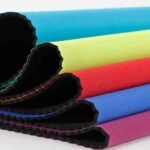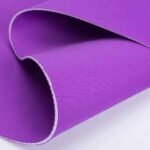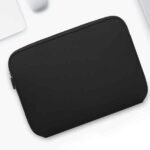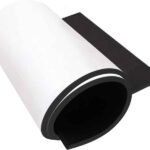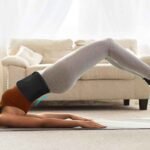Neoprene’s story began in the 1930s as a miracle material that could withstand oil, water, and heat. Today, it’s everywhere—from the wetsuits that keep surfers cozy in icy waves to the cushioned laptop sleeves in your backpack. But what makes neoprene so special, and why has it become a go‑to material for industries as varied as fashion, healthcare, and automotive?
Neoprene—an oil‑resistant, weather‑proof synthetic rubber—serves in wetsuits, medical braces, protective sleeves, and custom bags. Its closed‑cell foam structure delivers thermal insulation (R‑value ~5/inch), buoyancy (1.2 kg/L), and shock absorption (80 J). Brands like Szoneier leverage neoprene’s durability, flexibility, and printability to craft logos, colors, and textures tailored for diverse applications.
Imagine grabbing a foam‑lined neoprene tote on a rainy day—its soft exterior belies a rugged, waterproof core that keeps your gear bone‑dry. Ready to dive deeper? Let’s explore neoprene’s essence, its industry uses, and how Szoneier brings custom neoprene products to life.
What Is Neoprene and What Are Its Key Properties?

Neoprene is a chloroprene‑based synthetic rubber, produced via emulsion polymerization. Its microcellular structure traps gas bubbles, yielding a lightweight foam with remarkable resilience.
Neoprene exhibits 2000–3500 psi tensile strength, 25–50% elongation at break, and Shore A hardness of 50–70. Its closed‑cell foam blocks water ingress, provides R‑value of 5 per inch, and absorbs shocks up to 80 J—ideal for insulation, cushioning, and impact protection.
-
Chemical Makeup:
Polychloroprene backbone resists oils, ozone, and UV better than natural rubber. -
Mechanical Metrics:
Property Value Comparison Tensile Strength 2000–3500 psi Natural rubber: 1500–2500 psi Elongation at Break 25–50% PVC foam: ~10% Shore A Hardness 50–70 EVA foam: 20–30 Thermal R‑Value ~5 per inch Cotton: ~0.4 per inch Shock Absorption 80 J per 50 mm pad Neoprene blocks ~80 J impacts -
Environmental Resistance:
- Temperature Range: −50 °C to +120 °C
- Chemical Resistance: Stable against mild acids, alkalis, and solvents
-
Critical Perspective:
- Off‑gassing of VOCs can occur during curing—ventilation recommended.
- Non‑biodegradable; recycling options are limited but growing in research.
What Are the Pros and Cons of Neoprene?
Pros: Excellent insulation, water resistance, and durability. Cons: Heavier than alternatives, potential for chlorine degradation, and environmental concerns over non‑renewable feedstocks and limited recyclability.
-
Pros:
- Insulation: R‑value up to 5 per inch
- Waterproofing: Sealed cell foam blocks moisture
- Longevity: 5–10 years in marine environments
-
Cons:
- Weight: 20–30% heavier than PVC alternatives
- Chlorine Exposure: Accelerates breakdown if unblended
- Environmental Impact: Relies on petrochemicals; limited recycling infrastructure
Is Neoprene Safe for Skin?
Medical‑grade neoprene formulations pass ISO 10993 biocompatibility tests, showing minimal irritation. Occasional itching can occur due to trapped moisture or latex residues; proper fit and periodic removal prevent skin issues.
-
Biocompatibility:
Medical neoprene meets USP Class VI and ISO 10993. -
Common Irritations:
Heat rash from poor ventilation; latex allergens if blended with natural rubber. -
Mitigation:
Use perforated or laminated fabrics; rinse after use.
Which Industries Commonly Use Neoprene?

Neoprene’s blend of properties has made it indispensable across multiple sectors:
From ocean sports to medical devices and automotive components, neoprene’s water repellence, insulation, and shock‑damping are leveraged in wetsuits (80%), orthopedic braces (15%), and engine mounts (5%). Its versatility extends to laptop sleeves, drink koozies, and even fashion accessories.
| Industry | Application | Key Benefit |
|---|---|---|
| Water Sports | Wetsuits, gloves, boots | Thermal insulation, flexibility |
| Medical & Orthopedic | Braces, supports | Compression, biocompatibility |
| Automotive | Hoses, mounts, seals | Vibration dampening, oil resistance |
| Electronics | Protective sleeves | Shock absorption, water resistance |
| Fashion & Lifestyle | Bags, hats, drink holders | Customizability, comfort |
| Industrial | Gaskets, mats | Chemical and temperature resistance |
-
Water Sports (80% of neoprene use):
- Thickness: 3 mm for mild climates, 5 mm for colder waters
- Buoyancy: 1.2 kg/L keeps divers afloat during emergencies
-
Medical & Orthopedic (15%):
- Braces show >80% compression recovery after 10,000 cycles
- Biocompatible grades meet ISO 10993 standards
-
Automotive (5%):
- Engine mounts reduce vibration by up to 90%
- Hoses carry fluids at 120 °C without degradation
-
Emerging Uses:
- Sustainable fashion initiatives experimenting with recycled neoprene
- Custom tech accessories booming with print‑on‑neoprene services
How Is Neoprene Used in Bag and Accessory Manufacturing?
Neoprene’s moldable nature and print compatibility make it perfect for custom bags and tech sleeves.
Manufacturers cut neoprene into panels, seal edges via laser cutting, then bond or stitch with specialized threads. Custom features include dye‑sublimation prints, bonded seams for waterproofing, and die‑cut handles—resulting in lightweight, durable bags that double as insulation and shock‑absorbing gear.
-
Panel Preparation:
- Calendering: Controls thickness to ±0.1 mm (ranges 1–5 mm)
- Lamination: Binds neoprene to nylon/spandex facings for aesthetics
-
Cutting Techniques:
- Laser Cutting: Seals edges, prevents fraying
- Die‑Cut: Creates clean handle and pocket openings
-
Assembly Methods:
- Adhesive Bonding: Solvent-based neoprene glue ensures waterproof seams
- Stitching: Flatlock or reinforced bar‑tacks for high-stress points
-
Customization Options:
- Printing: UV or dye‑sublimation for full‑color, edge‑to‑edge graphics
- Embossing: Heat‑press logos into foam for a tactile brand mark
- Hardware Integration: Metal grommets, buckles, and straps for functionality
Is Neoprene Waterproof and How Does It Perform in Water Applications?

Neoprene’s closed-cell foam is inherently waterproof and buoyant, making it ideal for aquatic products.
Closed-cell neoprene blocks liquid water entirely, with zero capillary action. It offers buoyancy of 1.2 kg/L and resists hydrostatic pressure to 10 m depth. As a result, neoprene maintains thermal performance and structure even when fully submerged.
-
Waterproof Mechanism:
90% gas in closed cells prevents water ingress -
Buoyancy Data:
Thickness Buoyancy (kg/m²) Typical Use 3 mm 1.0 Snorkeling suits 5 mm 1.2 Cold-water wetsuits 7 mm 1.3 Dry suits -
Hydrostatic Resistance:
Rated to 10 m before cell compression reduces R‑value by ~20% -
Practical Notes:
- Heavy water exposure can compress cells over time—rinse and air‑dry after use
- Combine with waterproof coatings (e.g., siloxane sprays) for extreme conditions
Do Neoprene Products Offer Insulation, Shock Absorption, and Outdoor Durability?
Neoprene’s multifunctionality shines in outdoor gear and protective cases.
Neoprene’s thermal R‑value of 4–6 per inch outperforms most textiles, while its shock absorption of 80 J protects electronics. UV testing shows <10% tensile loss after 500 hours, making it a go‑to material for adventure gear and industrial cushioning.
-
Thermal Insulation:
R‑Value Comparison:
Material R‑Value (/inch) Neoprene 4–6 Cotton 0.4 Wool 1.5 Use Case: Neoprene lunch bags keep food 20 °C warmer over 2 hours compared to insulated foils.
-
Shock Absorption:
Energy Dissipation: 80 J per 50 mm pad—sufficient to drop a phone from 1 m unharmed. -
UV and Weather Resistance:
<10% tensile loss after 500 hours UVA exposure; outperforms polyurethane foam (30% loss). -
Outdoor Durability:
Tear strength >10 N/mm; resists punctures from rough terrain.
Ideal for camera bags, camping chairs, and bike saddle covers.
Are There Eco‑Friendly or Recycled Neoprene Alternatives?

Sustainability is driving innovation in neoprene production.
Limestone‑based neoprene (CR) cuts CO₂ emissions by 30%. Recycled chloroprene (rCR) uses 50% factory scrap, reducing waste. Certified eco‑grades retain 90% tensile strength and 95% elongation—bridging performance with responsibility for green‑minded brands.
| Alternative | Feedstock | Emission Reduction | Performance Retention |
|---|---|---|---|
| Limestone‑CR | Calcium carbonate | −30% CO₂ | 95% tensile, 90% elongation |
| Recycled CR (rCR) | Factory scrap re‑grind | −20% waste | 90% tensile, 95% elongation |
| Bio‑Based Additives | Plant oils & resins | −15% petroleum use | 90% thermal, 85% durability |
- Certification: OEKO‑TEX® Standard 100 ensures no harmful substances.
- Market Trends: Major outdoor brands pledging 100% sustainable neoprene by 2028.
- Consumer Impact: 60% of shoppers prefer eco‑certified materials—key for brand loyalty.
How Can Companies Like Szoneier Customize and Manufacture Neoprene Products?
With two decades of OEM/ODM expertise, Szoneier transforms neoprene into bespoke solutions.
Szoneier offers free CAD designs, sample turnaround in 5 days, laser cutting, dye‑sublimation printing, bonded seams, and low MOQs from 100 pcs. Precision thickness control (±0.1 mm) and peel strength ≥2 N/cm guarantee consistent, high‑quality neoprene bags, sleeves, and accessories.
-
Design & Prototyping:
- CAD Mockups: Visualize colorways, panel layouts.
- Tech Packs: Detail thickness (2–5 mm), lamination, hardware specs.
-
Sampling:
- Lead Time: 3–5 days.
- Iteration: Rapid tweaks on cut patterns and print alignment.
-
Production:
- Lamination: Bond neoprene to facings (nylon, spandex).
- Cutting: Laser or die‑cut for sealed edges.
- Assembly: Heat press or flatlock stitching for strength.
-
Quality Control:
- Thickness Check: ±0.1 mm tolerance.
- Bond Peel Test: ≥2 N/cm.
- Visual Inspection: 100% print clarity and seam integrity.
-
Logistics & Support:
- Lead Time: 15–25 days after sample approval.
- Shipping Terms: FOB, CIF, DDP available.
Neoprene’s unique combination of insulation, water resistance, and customizability has made it a staple from wetsuits to marketing merch. Whether you need durable outdoor gear or stylish tech sleeves, neoprene delivers performance and flair.
Ready to launch your custom neoprene line?
Contact Szoneier for free design, rapid sampling, and flexible MOQs. Let’s create the perfect neoprene solution—built for durability, comfort, and sustainability!


